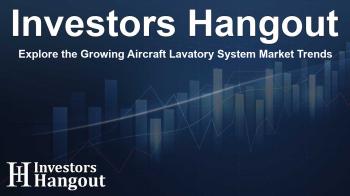Explore the Growing Aircraft Lavatory System Market Trends

Market Overview and Growth Forecast
The global aircraft lavatory system market is poised for significant growth, anticipating a growth rate of 3.7% annually. By the year 2034, it is expected to reach an estimated size of US$ 574 million. This projection highlights the increasing demand for advanced lavatory systems in aircraft, addressing evolving passenger expectations and operational efficiencies.
Insights from Stratview Research
Stratview Research has conducted a detailed analysis of the aircraft lavatory system market, presenting key insights into current market trends, competitive landscape, and segmented analysis. Their findings reveal a comprehensive outlook on global and regional market dynamics.
Market Highlights
According to Stratview’s report, several noteworthy factors contribute to the market's trajectory:
- The anticipated market size by 2034 stands at US$ 574 million.
- The compound annual growth rate (CAGR) is projected at 3.7% throughout the forecast period from 2024-2034.
- Essential segments covered include various aircraft types and lavatory configurations.
Segment Insights
The aircraft lavatory system market is segmented across various dimensions, which include: aircraft type, lavatory type, sales channel, and end-user type. Understanding these segments is crucial for stakeholders aiming to navigate the market effectively.
Aircraft Type Analysis
When analyzing by aircraft type, the market is divided into narrow-body and wide-body aircraft, along with regional aircraft and business jets. Notably, narrow-body aircraft have emerged as the largest segment regarding the demand for lavatory systems. The increase in short-haul flight activity and new aircraft models are significant contributors to this demand.
Understanding Lavatory Types
Lavatories in aircraft are categorized into standard, modular, and customized types. The standard lavatory continues to dominate the market; however, modular lavatories are anticipated to see rapid growth due to their maintenance efficiency and design flexibility, allowing for optimized space utilization.
End-User Dynamics
Market segmentation by end-user type points towards original equipment manufacturers (OEM) being the leading segment. This is primarily driven by new aircraft production and an uptick in manufacturing rates to accommodate passenger growth, necessitating advanced and efficient lavatory systems in modern aircraft.
Regional Market Insights
Geographically, North America is projected to retain its position as the most significant market for aircraft lavatory systems. This forecast is bolstered by the presence of major manufacturers and suppliers in the region, enhancing accessibility to components and technologies.
Asia-Pacific Growth Potential
Contrastingly, the Asia-Pacific region is expected to experience the highest growth rates within this sector. Increased air passenger traffic and the burgeoning focus on domestic aircraft production are pivotal drivers of this growth, particularly with manufacturers like COMAC enhancing regional capabilities.
Market Drivers
Several key drivers are stimulating growth within the aircraft lavatory system market:
- Enhanced demand for superior passenger experiences, emphasizing comfort and convenience.
- Modernization of aircraft fleets to incorporate advanced technologies.
- The rising preference for modular lavatory designs, ensuring operational efficiency and rapid maintenance.
Top Companies Leading the Market
In the competitive landscape, several companies have positioned themselves as leaders by innovating and enhancing their product offerings. Notable players include:
- Safran S.A.
- Jamco Corporation
- Diehl Stiftung & Co. KG
- Collins Aerospace
- EFW GmbH
- AVIC Cabin Systems Limited
- The Yokohama Rubber Co., Ltd.
- Boeing Encore Interiors LLC
- The Gill Corporation
- Euro-Composites Corporation
- HAECO Cabin Solutions
Conclusion and Future Outlook
The outlook for the aircraft lavatory system market remains promising, with various segments and regions poised for growth. Striving for improved passenger experiences and consistent modernization efforts will be vital as the industry continues to evolve and expand.
Frequently Asked Questions
What is the expected growth rate of the aircraft lavatory market?
The global aircraft lavatory system market is projected to grow at a rate of 3.7% annually through to 2034.
What will be the market size by 2034?
By 2034, the market size is anticipated to reach US$ 574 million.
Which regions are leading in the aircraft lavatory system market?
North America is expected to be the largest market, with Asia-Pacific showing rapid growth potential.
What types of aircraft are most affected by lavatory system demand?
Narrow-body aircraft are currently the largest demand drivers for lavatory systems.
Who are the top players in the aircraft lavatory system market?
Top companies include Safran, Jamco Corporation, and Collins Aerospace, among others.
About The Author
Contact Hannah Lewis privately here. Or send an email with ATTN: Hannah Lewis as the subject to contact@investorshangout.com.
About Investors Hangout
Investors Hangout is a leading online stock forum for financial discussion and learning, offering a wide range of free tools and resources. It draws in traders of all levels, who exchange market knowledge, investigate trading tactics, and keep an eye on industry developments in real time. Featuring financial articles, stock message boards, quotes, charts, company profiles, and live news updates. Through cooperative learning and a wealth of informational resources, it helps users from novices creating their first portfolios to experts honing their techniques. Join Investors Hangout today: https://investorshangout.com/
The content of this article is based on factual, publicly available information and does not represent legal, financial, or investment advice. Investors Hangout does not offer financial advice, and the author is not a licensed financial advisor. Consult a qualified advisor before making any financial or investment decisions based on this article. This article should not be considered advice to purchase, sell, or hold any securities or other investments. If any of the material provided here is inaccurate, please contact us for corrections.

